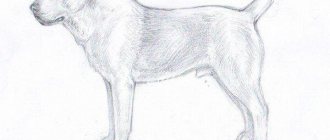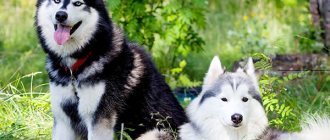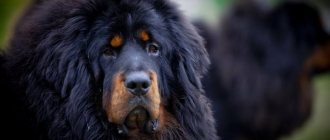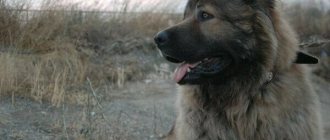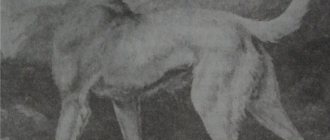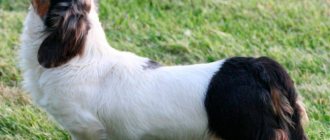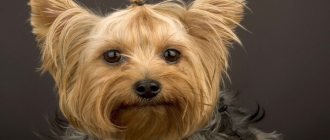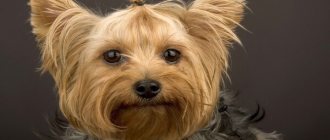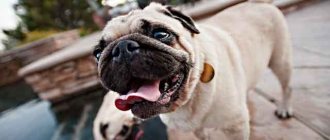Alabai, or, as it is more correct to call a representative of this breed, the Central Asian Shepherd Dog (SAO) is a large, brave, strong dog with a developed innate instinct of a hunter and guard.
Alabais rank 8th among the largest dogs in the world.
Despite their impressive size and menacing appearance, these beautiful animals look very harmonious and even graceful in appearance.
However, the restrained power, which cannot be overlooked in the alabai, inspires respect and even fear.
This article presents the types of the Alabai breed with their names, descriptions and photographs.
Breed standard
Central Asian Shepherds are large, well-proportioned dogs with well-developed muscles hidden under fairly thick skin.
An adult male of this breed grows at the withers to at least 70 cm and weighs at least 50 kg, and an adult female reaches a height of at least 62-65 cm with a body weight of 40 kg.
NOTE!
Due to sudden outbursts of aggression, these animals are listed as dangerous breeds in Russia and Ukraine and are banned in Denmark.
To meet the breed standard , Alabais must have:
- strong, muscular body with developed bones;
- wide chest, rounded ribs;
- straight back;
- wide and short loin;
- toned stomach;
- short neck with developed muscles;
- massive, wide head, almost rectangular in format;
- pronounced brow ridges;
- the forehead is wide and flat, the stop is not clearly expressed;
- the nose is straight, large black or brown;
- the eyes are round, set far apart, the iris is dark;
- scissor bite;
- paws are straight, long, muscular;
- ears are small, triangular, hanging;
- the tail is thick, saber-shaped, set low.
Alabai can be undocked , with ears and a tail of natural length, but in countries where docking is not prohibited by law, this procedure is traditionally carried out.
Nutrition
This may sound expected, but Alabai will have to be fed with a lot of food. They are large and massive, therefore, to maintain good functioning, they need to receive carbohydrates, minerals, beneficial extracts, proteins and other nutrients every day.
At the age of 2 to 8 months, the growth process of such a dog occurs. At this stage it is important to lay the foundation of his immune system. Proper feeding of the Alabai puppy determines whether it will get sick in the future.
So, the main product that he must eat daily until his final formation is meat. Usually, this product is given to shepherd dogs raw, but we advise you to first pour boiling water over it and then cool it. It's better to boil the meat. This will minimize the risk of parasites entering the animal’s body.
In addition, give your puppy dairy products, stewed vegetables and cereals every day. He needs all this. The following indicators indicate that your pet is eating properly:
- Shiny smooth coat.
- Activity, mobility.
- Satisfied look.
- Robust appearance.
Some people, who do not know about the rules of feeding Alabais, lead them to exhaustion. Many people simply cannot afford such a pet. It requires a large amount of food, at least 800 grams per day, keep that in mind.
An adult Central Asian Shepherd can be fed boiled cereals with added meat or dry food. The second option is much simpler, because standing at the stove for several hours every day to prepare the daily amount of food for the dog is tiring and problematic.
The size of a dog compared to a person
A comparison of the size of the Central Asian Shepherd Dog next to a person can be shown by its height at the withers or when it stands on its hind legs.
Thus, the average height of adult Alabais at the withers is at least 70, and more often 80 cm, which indicates that the head of a pet of this size will be almost at the level of the knees of a person of average height.
Standing on their hind legs, these dogs can be the same height as their owner or even taller.
So, when the largest, in fact, even huge, Alabai in the territory of the former USSR, nicknamed Bulldozer , stood on its hind legs, its height was about 2 m, which exceeded the height of its owner.
Care
You should regularly examine your ears and mouth; trim claws. It is recommended to rinse the eyes using tea leaves or special products.
The wool must be combed with a special brush. Shedding occurs twice a year, and at this time you need to comb it more often. Washing once or twice a year is enough; if necessary, no more than once a month.
It is necessary to carry out vaccinations, and 2-4 times a year - treatment against worms.
Character and temperament
Alabais are distinguished by calmness, self-confidence, balanced character and stable psyche. These are proud and independent animals, accustomed to making their own decisions and capable of obeying only those who prove their unconditional leadership.
Representatives of this breed have a developed territorial instinct, so they are wary and even aggressive towards strangers. These are brave, strong dogs who, if they sense that they or their family are in danger, will not hesitate to rush at the offender, even if he is larger.
Central Asian Shepherds are smart animals, they remember commands quite quickly and understand perfectly well what their owner wants from them. However, their inherent stubbornness, independence, predominance of protective instincts and tendency to dominate complicate the training process.
IMPORTANT!
Without proper training and early socialization, these dogs grow up uncontrollable and aggressive.
They can get along with other pets only after they have proven their leadership to them, which means that skirmishes and fights are almost inevitable at first. They will treat other people's animals with indifference only if they are properly and timely socialized; otherwise, all cats, birds, rodents and even dogs will be perceived by Alabai only as objects of hunting.
It is better not to have representatives of this breed in families with children under at least 6-7 years of age. Alabais are quite patient with children, but only if they respect their personal boundaries, which should not be expected from children. In addition, a large dog can accidentally startle, push or injure a child.
Upbringing
You should start raising a puppy from day one. The owner must immediately gain authority from the dog, otherwise it will be difficult to achieve obedience. Willful and freedom-loving, they demand respect and patience.
Alabai are offended by injustice; they perceive undeserved punishment as violence and become angry. Education should be based on trust, respect and authority of a person.
They love to test their owner for weakness and try to dominate. Therefore, it is important to maintain discipline by being persistent and consistent in education. The dog must unquestioningly follow all commands of the owner. A soft person should not have a dog of this breed.
From the age of three months, the puppy is taught the first commands. Dog training should be entrusted to an experienced professional.
Photos of popular species and their descriptions
Alabai is a common dog breed, especially in Asian countries. And each of them has its own vision of the ideal representative of this breed. Additionally, the appearance of each breed variety varies depending on its natural habitat.
Tibetan
The Tibetan Alabai is a large, shaggy and muscular dog with harmonious proportions and a moderately elongated body. Males grow to at least 70 cm at the withers with a body weight of 50 kg, females are 65 cm tall and weigh 40 kg.
Turkmen
They are considered the descendants of Tibetan mastiffs, which, after entering Central Asia, began to acquire features characteristic of modern Alabai.
These are guard dogs, not fighting dogs, but they can fend for themselves and protect their owner. They have a tendency to dominate and can get along with other animals only if they recognize their leadership qualities.
Turkmen Alabai
are fierce and independent, but also loyal, self-confident and have a balanced character and stable psyche.
Caucasian Shepherd Dog
Caucasian Shepherd Dogs are freedom-loving animals that will not obey anyone except their owner, in whom they will see the leader and leader. They are much more aggressive and impetuous than the Turkmen Alabais.
They do not require special care and live an average of 14-15 years. Height at the withers is about 65-75 cm, and body weight is 50-75 kg. Most often these dogs are used for protection. Due to their high degree of aggressiveness, such dogs must be kept with the utmost care.
Turkish Kangal
Representatives of the Turkish Kangal breed have been used since ancient times as fighting dogs, protectors and hunters.
These are obedient dogs, distinguished by speed, courage, endurance, vigilance, distrust and the ability to make decisions independently, assessing the situation. They are kind and flexible and get along well with other animals.
Height at the withers reaches 70-80 cm, weight – 55-65 kg. The coat can be gray-yellow or gray-brown.
Kyrgyz wolfhound (debit)
The breed is on the verge of extinction.
These wolfhounds were used primarily for herding. These are large, powerful animals with thick and straight hair; they can be either short- or long-haired. They have a calm character and are obedient. They grow up to 70-76 cm at the withers and weigh 40-70 kg.
Uzbek buribasar
Compared to other varieties of Alabai, the Uzbek Buribasar has a miniature stature, an elongated body and an elongated muzzle.
Smart, flexible, reserved dogs.
Kazakh tobet
Strong, hardy, large animals, reaching a height of 77 cm and a weight of about 45-65 kg. The coat is coarse and thick, piebald or spotted color is acceptable. They get along well with other animals and have a good guard instinct.
At the moment, the species is on the verge of extinction.
Siberian
The Siberian Alabai is a cross between a German Shepherd and a Siberian Husky. A large dog with thick fur. Characterized by a high level of intelligence, sociability, obedience and developed security and protective instincts.
Tajik
These dogs are larger than the Turkmen Alabay, have a heavier shape and resemble St. Bernards. Good-natured and reserved animals, good shepherds and loyal friends.
Alaskan Malamute)
There are 2 types of Malamutes: Kotzebue (with a wolf-colored coat) and M'Lut (coat of black and white, sable and white, white and blue). They grow up to 77 cm at the withers and weigh 55 kg. Friendly, intelligent, but sometimes overly stubborn dogs.
Armenian (Gampr)
These are viable, independent, self-sufficient dogs with short or long coats. Height is 65-78 cm, weight is approximately 60 kg.
Alabai from Afghanistan
One of the oldest dogs with a refined body, up to 75 cm tall and weighing 30-45 kg. Wool can be black, white, red, blue and other colors. Willful animals with a tendency to dominate.
Key points of training
Successful CAO training depends on several factors:
- Patience of the owner;
- Professional training of the trainer;
- Alabai's ability to learn.
Alabai is a stubborn animal, so during the training process it is important not to give up and ensure that all given commands are compulsorily followed. Otherwise, the dog will think that it does not have to obey and obey the requirements.
You can start training as early as 2 months of age. Ideally, immediately after the puppy appears in the house. It is important to be confident and calm during training. For good behavior, the dog should be rewarded with something tasty or simply praised. You cannot shout at the dog, much less hit it. Otherwise, there is a risk of losing the respect of the animal.
If punishment is necessary, you need to carefully take the puppy by the withers, shake it slightly, then say in a stern voice: “You can’t!” or “Ugh!”
Basic commands needed to train a dog:
- "Place!";
- "Lie!";
- "Near!";
- "Sit!";
- "To me!";
They are studied gradually; there is no need to try to master everything at once. Alabai need more time to master commands.
Read about how to properly train a dog in the article: “Training a puppy: effective methods from dog handlers, learning commands at home.”
Photos and descriptions of colors
The Alabai coat can be not only white or black and white, there are many possible variations of its color.
White
There are no albinos among the Alabais, even in the absence of a coloring pigment in the coat of these dogs, which is why it looks snow-white; the lips, nose and eyelids of the Alabais are colored black or brown.
Ginger
Red fur can have many shades: yellow-golden, fawn, light beige, reddish-red and copper-brown. The coat may be solid red or have white markings on the chest, belly, paws and face.
Dogs with a color called wolf look especially attractive: the main color of their coat is bright red or has a gray-brown tint, the hairs on the stomach, neck and chest are white, and the lower part of the forehead, cheeks and area around the eyes are black or dark -gray.
Black
The coat can be solid black or have dark brown, white or red spots.
The most common coat color of Alabais is a combination of black and white. If the main color of the coat is white, then black spots are located on the back, hind legs and top of the dogs head. In the case when the fur is black, the belly, chest and lower part of the paws of the Alabai are painted white.
brindle
The tiger alabai is the owner of wool, the color of which is combined with gray, brown or yellowish-golden colors. On the back, neck, croup and limbs there are dark stripes located transversely and closing into rings on the chest and belly.
Many individuals with this color have almost black fur on their faces, making it appear as if they are wearing masks.
Brown
Brown coat color varies from pure brown to brown.
NOTE!
In accordance with the standard, silver-blue and chocolate coat colors are considered unacceptable - it is believed that coat of such colors is characteristic of dogs that are a cross between an Alabai and a Great Dane or a German Shepherd.
Diseases
It is almost impossible to make any generalizations about the health of this species. Breeders claim that these are some of the healthiest individuals of all large breeds. The health of the Central Asian Shepherd is connected with its history. Dogs lived in some of the harshest conditions on Earth. At the same time, they fought against dangerous predators. Only the strongest could survive, and any genetic defects would be quickly eliminated.
However, those pets that have recently been crossed with other species may be susceptible to genetic diseases of those breeds.
The animal is known to have skeletal and visual problems. Therefore, owners are strongly advised to have new family members checked by veterinarians immediately. They will conduct genetic and other tests to identify potential health defects. This is especially valuable for conditions that appear in old age.
Large Alabai dogs are prone to the following problems:
- Hip dysplasia.
- Elbow dysplasia.
- Skeletal growth disorders.
- Heart failure.
- Heart problems.
- Problems with the spine.
- Arthritis.
- Bloating/Gastric Torsion.
- Progressive retinal atrophy.
- Cataract.
- Glaucoma.
- Heat intolerance.
- Deafness.
- Infections and parasites.
- Obesity.
- Dental problems.
Here is a detailed description of several serious diseases.
Hip dysplasia.
Hip dysplasia is one of the most common serious inherited diseases in domestic dogs. It is caused by a malformation of the above-mentioned joint.
Where the upper leg bone meets the femur, an “acetabulum” is created, shaped like a rounded, concave socket. In a healthy dog, the head of the femur, or kaput, fits almost perfectly into the acetabulum. Both are covered with a protective layer of cartilage. This cartilage prevents the two bones from rubbing directly against each other. The cause of the disease is a problem with the shape of the femur, the shape of the acetabulum, the cartilage between them, or perhaps some combination of these. Symptoms: lameness in the legs, the animal has difficulty standing up. Seek help from a specialist.
Bloating/Gastric Torsion.
Gastric torsion, more commonly known as bloat, is one of the most serious health problems in pet dogs. Without timely medical care, it usually leads to death. The death of a dog can happen in just one day!
In this condition, food and gas cannot leave the stomach. This promotes their accumulation, which increases bloating. As more and more food and bubbles become trapped, the stomach swells and expands.
The main symptoms: a sharp increase in the dog’s tummy, malaise, heavy breathing, vomiting with foam, pallor of the mucous membranes. Contact your veterinarian immediately.
Progressive retinal atrophy.
Progressive retinal atrophy is one of the most common genetically inherited conditions found in domestic dogs. This is the main cause of blindness in your pets.
The retina is located at the very back of the eye. It is responsible for collecting visual images and transmitting them to the brain through the optic nerve. The retina is divided into the inner or neural retina and the outer retina or retinal pigmented epithelium. The inner retina is further divided into nine layers, the outermost of which contains photoreceptor cells. They are usually called sticks.
The rods function in low light and detect shapes and movement. In animals with progressive retinal atrophy, rod cells are gradually destroyed. This happens until the dog becomes completely blind. The disease almost always affects both eyes equally, leaving the dog completely blind at one point. Symptoms: Your pet has decreased vision in low light or at dusk. For treatment, contact your veterinarian.
Glaucoma.
Glaucoma is an imbalance of fluid pressure in the eye. There is a fluid inside the eye called aqueous humor. Its composition is completely different from tears. Water humor is responsible for maintaining the correct shape and pressure inside the eye. It is constantly produced by the body, a process sometimes called "the tap." To maintain proper pressure, fluid must be drained regularly from the eye into the bloodstream. Water humor flows out of the eye through a mesh-like structure known as the drainage angle or "drain".
Glaucoma occurs when there is some problem with the drainage angle that prevents the proper release of aqueous humor. Water humor begins to fill the eye, causing it to expand like a balloon. As a result, intraocular pressure increases sharply.
Glaucoma varies greatly in severity and rate of occurrence. In some dogs, glaucoma worsens over weeks or months. For others, the condition results in permanent blindness over a period of days or even hours. Symptoms: watery eyes, constantly dilated pupil, swollen cornea, you notice that the animal sees worse. Contact your veterinarian for help.
Smooth-haired and long-haired dogs
Central Asian Shepherd Dogs have a coat consisting of 3 layers: dense undercoat, outer coat, and guard hairs. The hairs are thick and hard, dense and erect.
The area of natural residence of the Alabai affects their appearance, including the length of their coat. Depending on the length of the hairs, Alabai are divided into two types - long-haired and smooth-haired.
Longhair
Alabais living in mountainous areas are more massive, their subcutaneous fatty tissue is better developed, and the outer hair of such dogs is longer - 7-10 cm, fluffy. They have a well-developed mane and decorative hair on the withers, behind the ears, in the riding breeches and on the back of the tail.
Thanks to their low center of gravity, these dogs can maintain balance during mountain treks. They have a balanced nervous system, a well-developed vestibular apparatus and do not need constant contact with humans.
Long-haired Alabai do not require an insulated enclosure in winter; they tolerate any frost well.
The long-haired Central Asian dog is common in Turkmenistan, but it has not yet been recognized as an independent breed; officially it is a mongrel.
Smooth-haired
Dogs living in steppe regions have lighter bones and higher legs, they are more mobile and have a smooth (3-5 cm in length) coat. The short-haired Alabai has a more active psyche, it is more sociable and easier to train.
Their coat is uniform throughout the body, shortened on the front side of the paws and slightly lengthened at the withers.
Price
There are several kennels in Moscow where Central Asian Shepherds are bred. There they monitor their health, weight, nutrition, etc. We recommend making a purchase at such an institution.
The price of an Alabai from a breeding Moscow nursery for 2022 is 35-40 thousand rubles. Private dog breeders sell puppies of this breed much cheaper, from 5 to 20 thousand rubles.
Before you take the animal home, evaluate its appearance. He must be strong, curious and cheerful. A 2-month-old Central Asian Shepherd puppy must remain stable. If he falls while walking or running, he probably doesn't have enough calcium in his body. You shouldn't buy such a dog.
Mini-Alabai - a defect or a separate breed?
Central Asian Shepherds that have not reached the height at the withers established by the standard (the so-called mini) are considered a defective breed.
Such deviations can arise as a result of genetic changes, interbreed mating, the purpose of which was to produce smaller dogs, or as a result of a lack in the puppy’s body of vitamins, macro- and microelements necessary for proper and healthy growth and development.
However, small representatives of the breed, which are quite suitable for keeping even in city apartments, are in demand among those who like Central Asian Shepherds, but a number of reasons do not allow them to have such a pet.
IMPORTANT!
As a rule, a small (dwarf) representative of the breed, in addition to stunting, has other deviations in appearance and health problems.
Health
Central Asian Shepherds are distinguished by good health. But errors in maintenance and feeding harm the dog.
Lack of exercise leads to obesity, and improper feeding leads to diabetes.
In addition, Alabai are prone to diseases of the musculoskeletal system and cardiovascular system.
If raised incorrectly, they suffer from neurosis.
Are boys different from girls?
During the first 6 months of life, the exterior of Alabai dogs is identical in males and females, and it is impossible to determine the gender of a puppy just by looking at it.
When dogs reach the age of 9-10 months, their exterior differences are already pronounced. The male's height at the withers reaches 80 cm, he weighs about 70 kg and has a massive overweight body and a bear-like large head. the girl, in turn, has a more graceful silhouette, she grows up to 70 cm at the withers and weighs 60 kg.
Tail proportions
It is prohibited for Alabai to have their tail docked short because of its functional significance. With its help, the animal expresses emotions and shows the owner its condition. It is designed for balance, helps pets run.
In their historical homeland, it is customary to cut off the tails of animals by half; only males undergo the operation. In other places, the rules have undergone changes: the operation involves excision in the zone of transition of the last section of the spine from thick to thin.
How to choose a puppy?
Before buying an Alabai puppy , you need to find out from the breeder the age of the bitch and the size of the litter. So, if the bitch is older than 8 years old or more than 5 puppies were born in the litter, then the likelihood of them developing serious diseases increases significantly.
It is also necessary to examine the puppy - if the Alabai is purebred and healthy, it has:
- smooth, “plush”, shiny coat without dandruff and bald patches;
- clean skin without rashes and inflammations;
- scissor bite;
- pink mucous membranes;
- clear eyes without signs of souring and increased lacrimation;
- clean ears without unpleasant odor or discharge.
NOTE!
In addition, the puppy should not have a bloated belly, excess weight or, on the contrary, signs of exhaustion or parasites. He should be active, playful and inquisitive.
Veterinarians' opinion
Many veterinarians are against docking Alabais. The only exceptions may be medical indications. Often specialists refuse to perform such operations, especially if the animal is already a month old. In such a situation, general anesthesia is necessary, and this negatively affects the puppy’s health.
Docking Alabais is not a mandatory procedure. Veterinarians say that it should only be done in cases of extreme necessity. Alabai without cropped ears can also claim victory in the exhibition, like his cropped brother.
*Prices are as of November 2022.
Combing
Alabai has thick and short fur. Usually it does not roll down and tangles do not form. To maintain a neat appearance of the animal, one brushing per week is enough. After a walk, you need to select small debris, branches and burrs from the animal’s fur.
The giant alabai looks more like a bear
However, during the molting period, the amount of scratching should be significantly increased. Alabai sheds profusely, during this period a furminator . In 1 period, the shed wool is enough to knit a warm sweater for an adult. Many housewives really put their pet's hair to work.
Advice! An animal should be taught to comb from childhood. If you postpone lessons until later, an attempt at grooming may cause a protest from the animal.
Possible complications
Common consequences of intervention include:
- bleeding - occurs in mature dogs and requires the help of a veterinarian;
- seals and scars - they spoil the appearance, but do not cause inconvenience; they arise due to late surgery;
- associated infection - pathogenic microorganisms penetrate the wounds due to poor treatment, and then inflammation develops in the cut areas.
If unusual reactions occur (fever, suppuration, bleeding), the pet should be shown to a veterinarian and given a course of symptomatic therapy.
Alabais with uncropped ears look no worse than their operated Central Asian relatives. The decision about the need for surgery remains with the owner.
Application
The Turkmen Alabai is an excellent protector and watchman. He will carefully guard the territory entrusted to him from any encroachment. The dog will not let strangers through.
It is better not to enter the giant's domain without the owner's permission. Representatives of the breed are equally good at guarding large objects and small private farms - their security qualities are comparable to the Moscow watchdog .
If a dog recognizes a person as a leader, it will protect him from any attacks by enemies. The wolfhound will not allow its owner to be harmed.
Little teddy bears will soon turn into real strong bears
Pet habits
Despite his advanced age, Bulldozer continues to lead an active lifestyle and maintain good physical shape.
Daily walks are still an important part of a dog’s life, so even now the dog is beautiful, fit and has well-developed muscles. Every day the dog runs at least 6 km, without weekends or holidays.
The room where Bulldozer lives is always kept clean and the dog can calmly rest alone. The 9-year-old pet often takes advantage of this privilege and rests away from the hustle and bustle.
Even at this advanced age, the dog tolerates cold, heat and sudden temperature changes well. The dog is not fussy about food, but eats quite a lot.
NOTE!
Alabai is a proud, calm and stubborn dog, prone to taking a leadership position and requiring willpower and patience. A dog that has not completed an obedience course before 6-7 months can become potentially dangerous both for the owner and for strangers.
